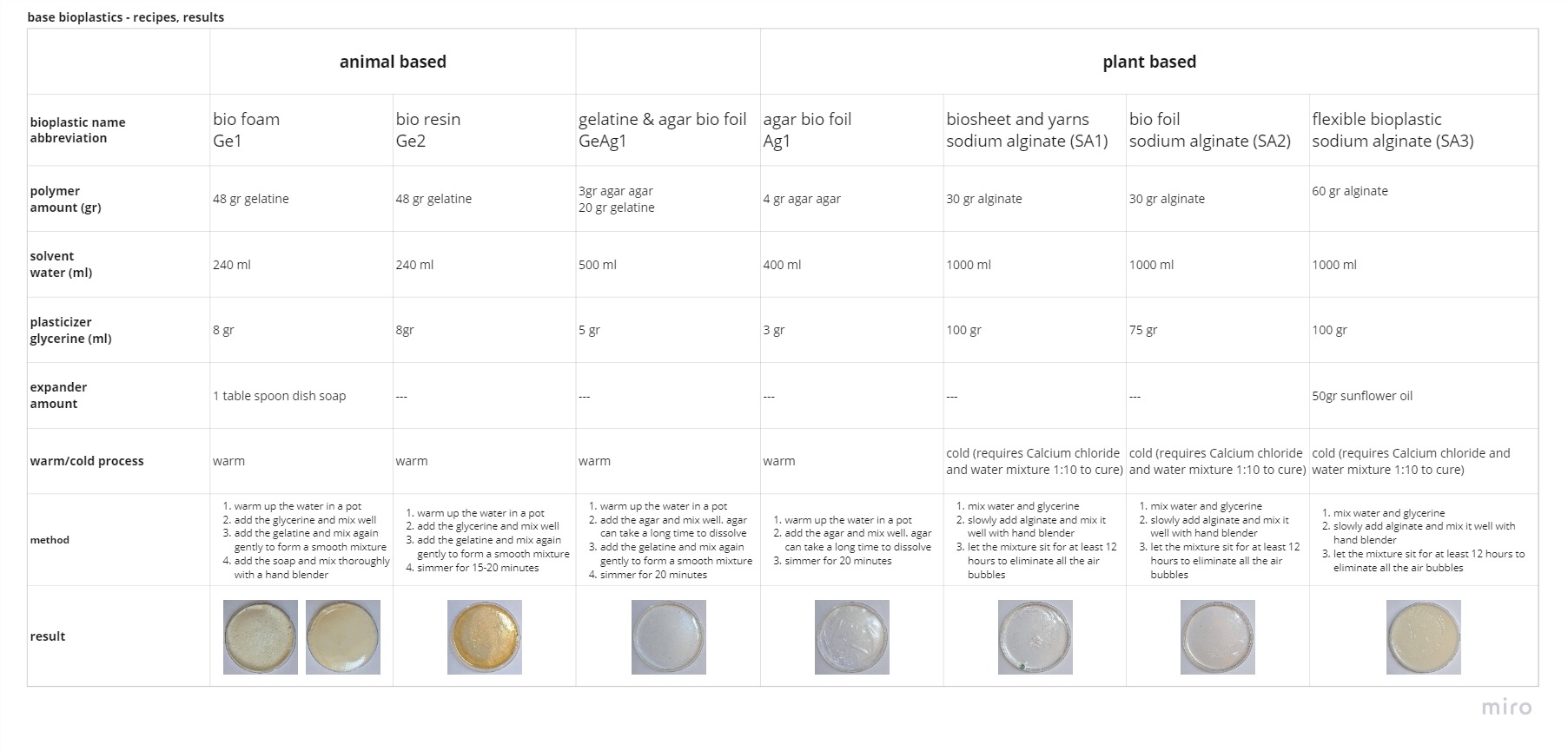6. BioFabricating Materials¶
Research & Ideation¶
This is another exciting week for me. I had never made bioplastics myself, although I co-taught a basic design course where students prepared bioplastic samples to cast as modules. So it was a different perspective and first-hand experience for me.
Going into this week, I wanted to explore changes in material/finish/structural properties of base bioplastic recipes with different fillers, creating composites.
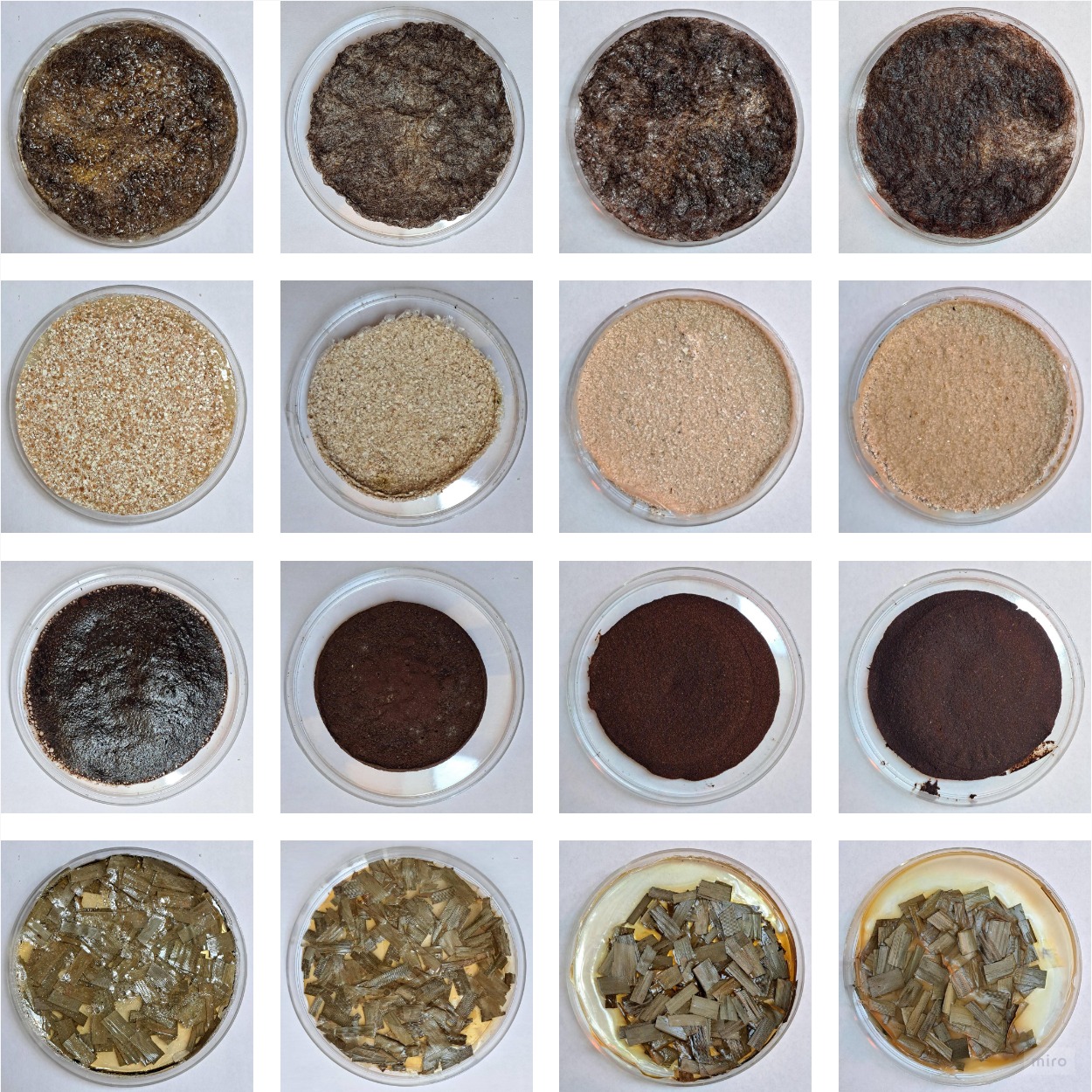
References & Inspiration¶
My researched of this week focused on making sense of experiment processes and outcomes. So I observed how data is made explicit in various sources.
I find Materiom as a good recipe and resource site for finding different bioplastic recipes. If you login/create an account, you can view different bioplastics recipes, make queries with different filters and compare some of them according to material properties. You can also contribute to grow their database.

Other material websites which I find inspiring as well as a good resource to understand how to expliticize material properties. One of them is Future Materials Bank and the other one is Material District.

A few other references:
- How to test the strength of bioplastics, a video tutorial. I haven't used this method, however it is a good reference for the future.
- Here is a really short recap of bioplastics, if you are in the mood for just a small dose.
- Bioplastic Cook Book
- The Chemarts Cookbook
- Bioplastic Tools and Recipes: I liked the extent of physical attributes explored.
Here is an interior design studio, undergraduate project which explores local materials and bioplastics made with them:
Tools¶
Biobased plastics ingredients:
- Polymer: Gelatine, Agar Agar, Sodium Alginate
- Solvent: Water
- Plasticizer: Gylcerine
- Filler & Stiffener: Wool, Eggshells, ground and recycled Coffee, Bamboo Leaves
- Expander: dish soap
- Colorant: mica powder, pigment from biochromes, bought ink (contains arabic gum)
- For curing alginate: Calcium chloride
Biobased plastics tools:
- Stove
- Pot
- Teaspoon, tablespoon, ladle, wooden spoon
- Kitchen scale
- Sensitive pharmacy scale
- Containers and bowls of various sizes
- Whisk
- Hand blender
- Petri dish
- Dehydrator
- Syringe
Fish leather ingredients and tools:
- The skin of a fish (I used eel skin)
- Egg
- Olive oil
- Dish soap
- Bowl
Kombucha leather ingredients and tools:
- Unpasteurized kombucha drink
- A form of sugar: glycerine, fructose, granulated sugar, dextrose
- Brewing content: various teas (rooibos, green tea, etc.), beer
- Water
- White vinegar
- Rubbing alcohol
- Containers with lids
- Heating pads
Process and workflow¶
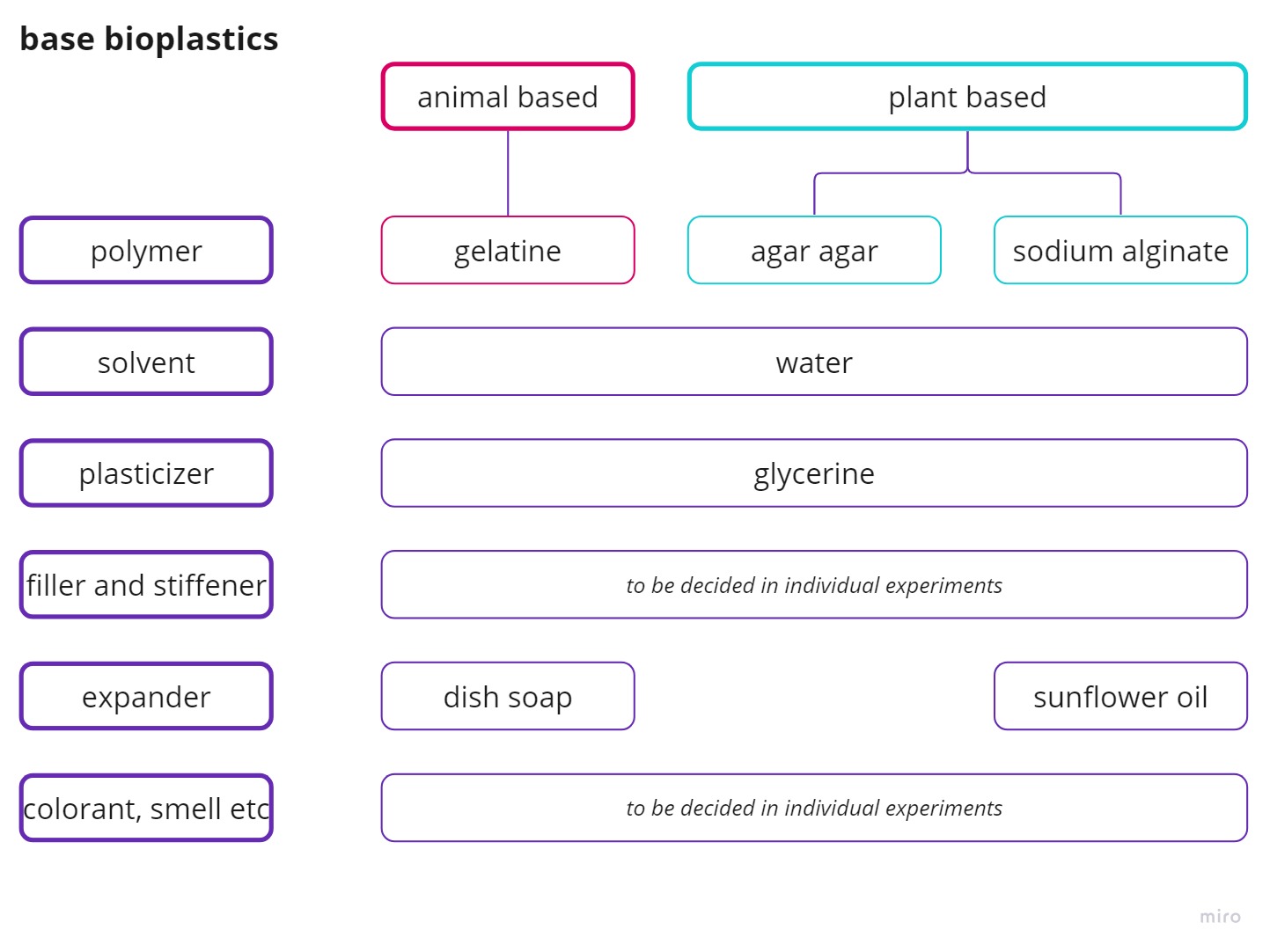
Base bioplastics of gelatine, agar agar and sodium alginate¶
In the lab, we prepared 4 pots with gelatine and agar agar as well as three mixtures of sodium alginate with different compositions.
Fish leather¶
There are a few recipes to tan a fish skin. We used 3 different recipes in the lab. I used the following recipe from Lotta Rahme:
Ingredients:
- The skin of a fish
- 1dl grapeseed oil or olive oil
- 1 egg yolk
- 1 teaspoon of soap
Method:
Remove all the flesh and scales from the fish skin. I used an eel skin for my leather. I found tablespoon as a good tool to remove flech and scales. Squeeze all the water out. Add the above ingredients in a bowl. This mixture can be used for 3-4 skins. Put the fish skin in the mixture and work it 10-15 minutes, rubbing the mixture on the skin. Hang the skin. During the drying, work your skin frequently for better results.
After 3 days, wash the skin in soap and water mixture at 20 degree celcius. The skin is very stiff at this point. You need to work your skin against a sturdy frame to soften it. Ideally, put the skin on a board flat to dry. I did not have a proper place and board so I hung it again to dry.

In the lab, people also used salmon skin. I think salmon skin is a better option than eel skin, because:
- it has a wider width
- The scale side has a better looking finish
- The overall feel of the leather is better than eel.
Kombucha leather¶
This is still a work-in-progress as kombucha leather making process takes around 1 month. We prepared 3 batches of kombucha mixtures during the biofabricating materials week to harvest our materials later.
| Batch 1 | Batch 2 | Batch 3 | |
|---|---|---|---|
| Sugar | 250gr fructose, 300 gr granulated sugar | 300 gr glycerine | 200 gr glucose |
| Brewing content | 3lt beer | 1,5 lt water, 50 gr green tea | 1,5 lt water, 100 gr rooibos tea |
| Water | 3lt | 1,5 lt | 2 lt |
| Unpasteurized kombucha | 500 ml | 500 ml | 500 ml |
Clean the containers with lids with rubbing alcohol. Any contamination is your enemy while growing kombucha bacteria, therefore it is really important to sterilize the containers.
Prepare your mixtures for each batch in containers by adding brewing content, sugar and water. Wait until the the temperature in each container is not more then 30 degree celcius. Kombucha bacteria are also very sensitive to heat: if temperature is high, they die; if temperature is low, they cannot grow. Add unpasteurized kombucha in each container and put the containers on heating pads. Amsterdam is cold nowadays. You need constant 30 degree celcius and heating pads help.
Approximately 84 hours after preparing the mixtures, we discovered mold growth on the surface of the mixtures. We added white vinegar (the amount does not matter, but we added a lot) to kill the mold bacteria as per suggested by Cecilia.

Creating reinforced composites (personal experiment)¶
I took on the personal exploration of creating composites with different reinforcement by adding different fillers and stiffeners as well as colorants to base bioplastic recipes that we created together. The aim was to achieve different material, visual and structural properties.
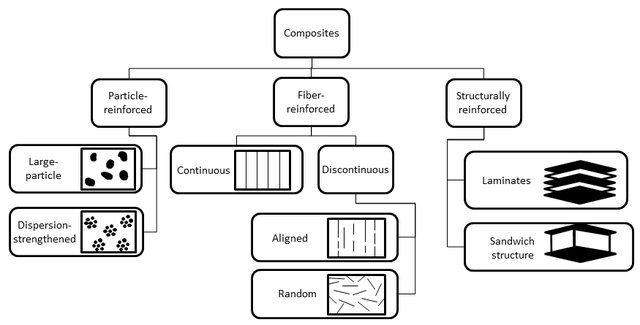
I used wool, bamboo leaves, eggshell and recycled ground coffee as fillers and stiffeners. Comparing with the above chart, eggshell and coffee act as large particles, wool act as continuous fiber reinforcement and bamboo leaves act as discontinuous-random reinforcement.

Wool composites¶
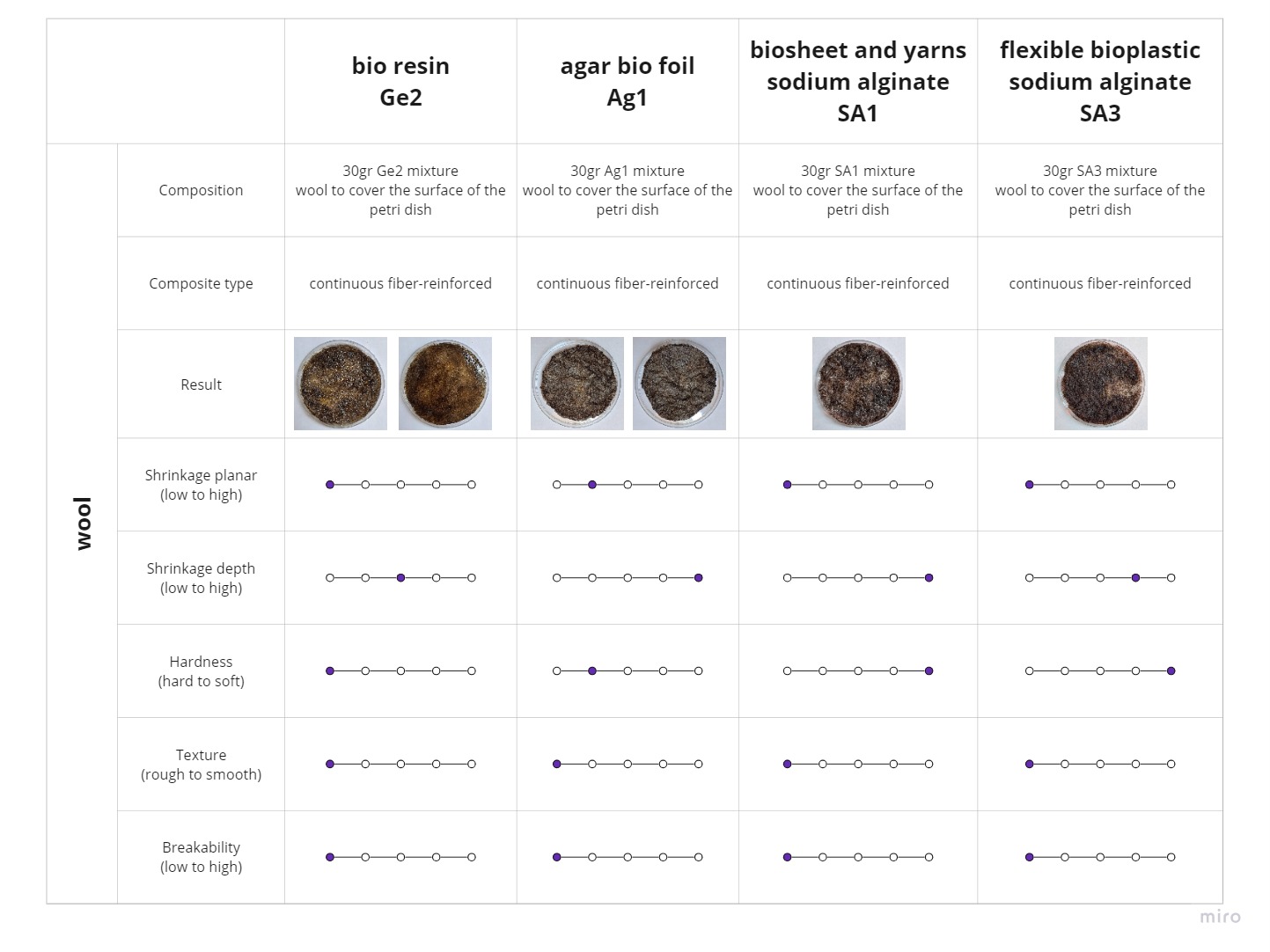
Eggshell composites¶

Coffee composites¶

Bamboo leaves composites¶

Notes from the Classroom¶
notes from the classroom
BIOFABRICATING MATERIALS lecture by CECILIA
Bio - plastics, yarns&fabrics, leathers
Bio - based (bacterial, fungal, vegetal, mineral, biosynthetic and animal), degradable (degrade in specific conditions - pH-sensitive, thermo-sensitive, enzymes), compostable (composted within 90 days - bacteria, mycelium, animal, etc.)
BIOBASED
- Animal - gelatine, collagen, fat, silk, spider-silk, (fish) skin, leather, hair
- Vegetal - glycerine, lignin, alginate, cellulose, food waste, seed-oil, plants, fruits, seeds
- Microbial - cellulose, bacteria, bioshades, pigments
- Fungal - fungii, mycelium
- Biosynthetic - cellulose, ...
WHY BIO?
synthetics seem to seep into environment. plastic is a substance the earth cannot digest.
PLASTICS is a word that originally meant "pliable and easily shaped". Polymer + plasticizer (to create flexibility)/filler(to avoid shrinkage)/stiffening(to structure and reinforce)/expanding(to create foams) + color (pigment)
BIOPLASTICS
Agar & Alginate Bioplastics Gelatine Vegetal Waste
Alternative Leathers
- Microbial
- Mycelium
- Vegetal
- Animal waste
- Fruit
- Hi-tech or lab grown
BIOFABRICS & YARNS
- Plant Matters
- Rooted in nature
- ....
HOW TO CRAFT BIO-PLASTICS?
polymer (alginate, gelatine, starch...) + glycerine / egg shells, chalk, fibers, oils, etc. / fibers, natural debri / green soaps, emulsifiers
BIOMATERIALS DESIGN PROPERTIES
- Structural
- Structural decorative
- Sensorial texture, visual texture
- Structural color (with refraction sheets)
- Structural color & augmented properties (with holographic charcoal activated)
- Color, texture and transperancy
AGAR & ALGINATE BIOPLASTICS
Agar: Agar agar, glycerol, water (not heat resistant)
Alginate: sodium alginate, glycerol, water, calcium chloride hydrate (water resistant, but pH sensitive, heat resistant)
GELATINE BIOPLASTICS
Gelatine(buy the powered not the sheet), glycerol, water (not very water and totally not heat resistant, but you can recast it and it makes the plastic sturdier)
VEGETAL BIOPLASTICS
Cellulose recipes: Aalto chemarts, the Chemarts Cookbook
WASTE BIOPLASTICS
Fishscale plastics, blood waste, carrot waste, casein whey waste (marieke's bio scoring system)
ALTERNATIVE LEATHERS
Grown: Microbial (scoby - kombucha starter 25-30 degree celcius), mycelium
Crafted
- vegetal leathers, fruit leathers
- animal waste leather
- fish-skin leather
BIO FABRICS & YARNS
Grown: root fabrics, spider silk
Crafted: leaf & flower yarn
- Plant matters... chemarts recipe book (fiber extraction)
- Rooted in nature
- Algae fabrics and yarns
- Animal & human resource
- Spider silk
